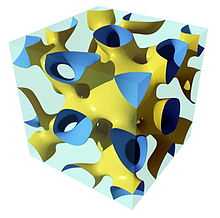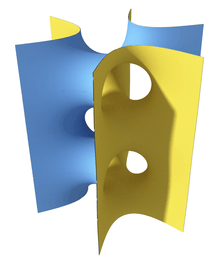Lidinoid

Lidinoid in a unit cell.
In differential geometry, the lidinoid is a triply periodic minimal surface. The name comes from its Swedish discoverer Sven Lidin (who called it the HG surface).[1]
It has many similarities to the gyroid, and just as the gyroid is the unique embedded member of the associate family of the Schwarz P surface the lidinoid is the unique embedded member of the associate family of the Schwarz H surface.[2] It belongs to space group 230(Ia3d).
The Lidinoid can be expressed as a level set:[3]
References
- ↑ Lidin, Sven; Larsson, Stefan (1990). "Bonnet Transformation of Infinite Periodic Minimal Surfaces with Hexagonal Symmetry". J. Chem Soc. Faraday Trans 86 (5): 769–775. doi:10.1039/FT9908600769.
- ↑ Adam G. Weyhaupt (2008). "Deformations of the gyroid and lidinoid minimal surfaces". Pacific Journal of Mathematics 235 (1): 137–171. doi:10.2140/pjm.2008.235.137.
- ↑ The lidionoid in the Scientific Graphic Project
External images
| ||||||||
![\begin{align}
(1/2)[&\sin(2x) \cos(y)\sin(z)\\
+ &\sin(2y)\cos(z) \sin(x)\\
+ &\sin(2z)\cos(x) \sin(y)]\\
-& (1/2)[\cos(2x)\cos(2y)\\
+ &\cos(2y)\cos(2z)\\
+ &\cos(2z)\cos(2x)] + 0.15 = 0
\end{align}](../I/m/70fb90cc4f7ca2139ae9970e73074a67.png)
